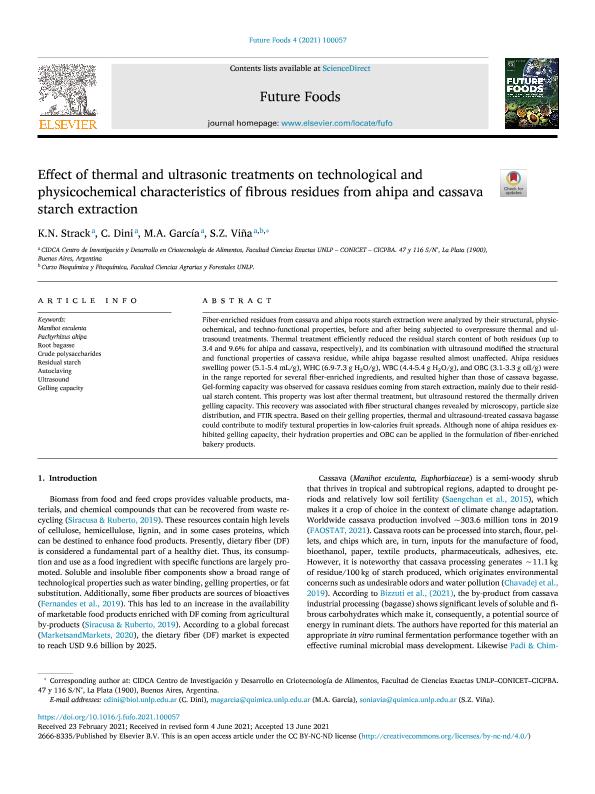Artículo
Effect of thermal and ultrasonic treatments on technological and physicochemical characteristics of fibrous residues from ahipa and cassava starch extraction
Fecha de publicación:
12/2021
Editorial:
Elsevier Science
Revista:
Future Foods
ISSN:
2666-8335
Idioma:
Inglés
Tipo de recurso:
Artículo publicado
Clasificación temática:
Resumen
Fiber-enriched residues from cassava and ahipa roots starch extraction were analyzed by their structural, physicochemical, and techno-functional properties, before and after being subjected to overpressure thermal and ultrasound treatments. Thermal treatment efficiently reduced the residual starch content of both residues (up to 3.4 and 9.6% for ahipa and cassava, respectively), and its combination with ultrasound modified the structural and functional properties of cassava residue, while ahipa bagasse resulted almost unaffected. Ahipa residues swelling power (5.1-5.4 mL/g), WHC (6.9-7.3 g H2O/g), WBC (4.4-5.4 g H2O/g), and OBC (3.1-3.3 g oil/g) were in the range reported for several fiber-enriched ingredients, and resulted higher than those of cassava bagasse. Gel-forming capacity was observed for cassava residues coming from starch extraction, mainly due to their residual starch content. This property was lost after thermal treatment, but ultrasound restored the thermally driven gelling capacity. This recovery was associated with fiber structural changes revealed by microscopy, particle size distribution, and FTIR spectra. Based on their gelling properties, thermal and ultrasound-treated cassava bagasse could contribute to modify textural properties in low-calories fruit spreads. Although none of ahipa residues exhibited gelling capacity, their hydration properties and OBC can be applied in the formulation of fiber-enriched bakery products.
Archivos asociados
Licencia
Identificadores
Colecciones
Articulos(CIDCA)
Articulos de CENTRO DE INV EN CRIOTECNOLOGIA DE ALIMENTOS (I)
Articulos de CENTRO DE INV EN CRIOTECNOLOGIA DE ALIMENTOS (I)
Citación
Strack, Karen Nataly; Dini, Cecilia; Garcia, Maria Alejandra; Viña, Sonia Zulma; Effect of thermal and ultrasonic treatments on technological and physicochemical characteristics of fibrous residues from ahipa and cassava starch extraction; Elsevier Science; Future Foods; 4; 12-2021; 1-9
Compartir
Altmétricas




